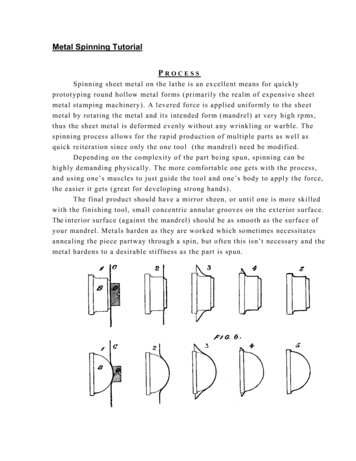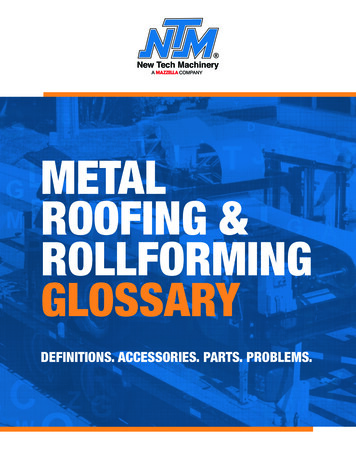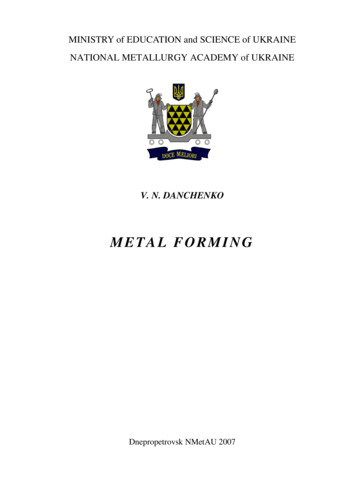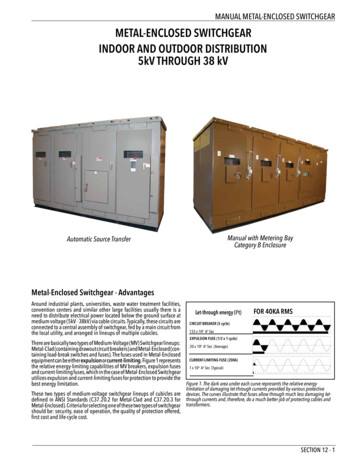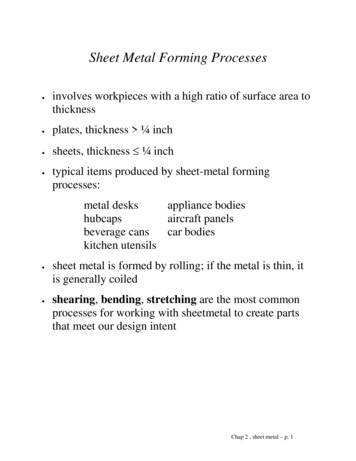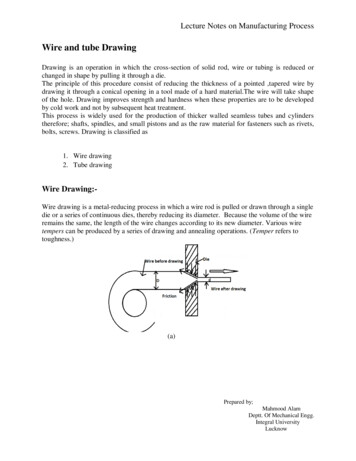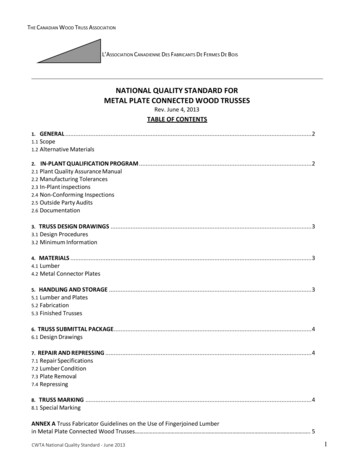
Transcription
THE CANADIAN WOOD TRUSS ASSOCIATIONL’ASSOCIATION CANADIENNE DES FABRICANTS DE FERMES DE BOISNATIONAL QUALITY STANDARD FORMETAL PLATE CONNECTED WOOD TRUSSESRev. June 4, 2013TABLE OF CONTENTS1.1.11.2GENERAL . 2ScopeAlternative Materials2.2.12.22.32.42.52.6IN PLANT QUALIFICATION PROGRAM . 2Plant Quality Assurance ManualManufacturing TolerancesIn Plant inspectionsNon Conforming InspectionsOutside Party AuditsDocumentation3. TRUSS DESIGN DRAWINGS . 33.1 Design Procedures3.2Minimum Information4. MATERIALS . 34.1 Lumber4.2 Metal Connector Plates5. HANDLING AND STORAGE . 35.1 Lumber and Plates5.2 Fabrication5.3Finished Trusses6. TRUSS SUBMITTAL PACKAGE . 46.1 Design Drawings7. REPAIR AND REPRESSING . 47.1 Repair Specifications7.2 Lumber Condition7.3 Plate Removal7.4 Repressing8. TRUSS MARKING . 48.1 Special MarkingANNEX A Truss Fabricator Guidelines on the Use of Fingerjoined Lumberin Metal Plate Connected Wood Trusses . 5CWTA National Quality Standard - June 20131
Reference Publications Truss Plate Institute of Canada (TPIC), Truss Design Procedures and Specifications for LightMetal Plate Connected Wood TrussesNational Lumber Grade Authority (NLGA), Standard Grading Rules/Special Product StandardsFPInnovations, Truss Fabricator Guidelines on the Use of Fingerjoined Lumber in Metal PlateConnected Trusses1. GENERAL1.1. ScopeThis standard is a quality standard for the manufacturing of metal plate connected wood trussesand shall be used in conjunction with an in plant quality assurance program. It is intended toprovide the basic quality requirements to enable truss plants to demonstrate conformance withindustry standards.1.2. Alternative MaterialsWhere alternative material is used, additional requirements such as found in Annex A, "TrussFabricator Guidelines on the Use of Fingerjoined Lumber in Metal Plate Connected Wood Trusses"shall also apply.2. IN PLANT QUALIFICATION PROGRAM2.1. Plant Quality Assurance ManualEach qualified truss plant shall have a plant quality assurance manual complying with thisstandard and approved by the Regional Association1. It shall contain documentation of qualitycontrol procedures which include the requirements for initial plant qualification and for ongoingquality control.2.2. Manufacturing TolerancesManufacturing tolerances shall be in accordance with TPIC "Truss Design Procedures andSpecifications for Light Metal Plate Connected Wood Trusses", Appendix G, and this standard.2.3. In Plant InspectionsA minimum inspection of three trusses per operational set up location per shift, per week shall becompleted and duly recorded. Trusses sampled for inspection shall be as finished off theproduction line or preferably from yard storage. They shall, as much as practicable, be the typerepresentative of the range of production. Inspections shall follow a format that includes themanufacturing and material variances prescribed in TPIC Appendix G, and this standard.2.4. Non Conforming InspectionsTrusses that do not meet minimum allowances for material defects and variances in workmanshipshall be documented with follow up repair, rework or replacement as instructed and documentedby the truss designer.1The term "Regional Association" means an entity representing one or more light metal plate connected wood truss plantsand possibly associated industries within a given geographical region.CWTA National Quality Standard - June 20132
2.5. Outside Party AuditsAudits shall be conducted at a minimum frequency of two times per year unless the plant isinactive for a period of at least 6 months. They shall be random and unannounced and reasonablydistributed during the year. These audits are intended to verify the plant's ongoing conformancewith this standard and Regional Association requirements. They are to be conducted by qualifiedindividuals approved by the Regional Association.2.6. DocumentationThe plant shall maintain all records of in house inspections including outside party audits for aminimum of 5 years. The Regional Association shall maintain a current list of qualified plants thatcan be made available to interested parties.3. TRUSS DESIGN DRAWINGS3.1. Design ProceduresAll trusses shall be designed in accordance with TPIC procedures.3.2. Minimum InformationMinimum information shall be in accordance with TPIC "Minimum Information on Truss DesignDrawings", Appendix H.4. MATERIALS4.1. LumberAll trusses shall be manufactured using dimension lumber graded and stamped according to NLGARules including applicable NLGA Special Products Standards.4.2. Metal Connector PlatesAll metal connector plates shall be in accordance with TPIC Appendix G. Substitute (larger) sizesare acceptable provided the plate is the same type, gauge and orientation as the plate beingspecified. No dimension can be less, and the tooth count in each joint member shall equal orexceed the original requirement. Plates shall not project past truss profiles or internal boundarieswhere clear space is required by the design specifications i.e. duct chases in floor trusses, roomspace in attic trusses.5. HANDLING AND STORAGE5.1. Lumber and platesLumber and plates shall be stored in a way to protect against the elements.5.2. FabricationAny damage to trusses during fabrication and handling relevant to Section 1.2, AlternativeMaterials shall be recorded and made available to the Regional Association.5.3. Finished TrussesTrusses shall be handled and stored in a way to prevent damage (excessive bending, overstressingjoints and lumber). They shall be protected from excessive moisture including excessive groundcontact.CWTA National Quality Standard - June 20133
6. TRUSS SUBMITTAL PACKAGE6.1. Design DrawingsThe truss submittal package shall contain individual truss design drawings, including requirementsfor web bracing, or otherwise in accordance with the Authority Having Jurisdiction.7. REPAIR AND REPRESSING7.1. Repair SpecificationsWhen any installed (i.e. embedded) connector plate does not meet plating requirements the trussdesigner shall do one of the following:(a) Specify the repair removing the plate(b) Specify the repair leaving the plate in place, or(c) Review and approve the plate "as is".7.2. Lumber ConditionWhen a connector plate is installed in a connection area of lumber that contains tooth holes(wood otherwise not damaged) from a previously installed plate, connector plate teeth shall beconsidered 50% effective at the location where they cover the tooth holes.7.3. Plate RemovalConnector plate teeth installed into lumber which has been damaged (i.e. wood removed, orexcessive splits) by the installation/removal of a previous connector plate shall be consideredineffective in the damaged areas.7.4. RepressingConnector plates may be repressed during manufacture to improve plate embedment.8. TRUSS MARKING8.1. Plant Qualification MarkingAppropriate truss marking (stamps, tags) should be used to provide evidence of plant qualificationto standards.8.2. Special markingBearing locations other than truss heels, and locations of point loads shall be identified withstamps, tags or other appropriate marking on each truss, or with the drawings that accompanythe truss shipment. Bottom chord bearing parallel chord truss shall be clearly marked to avoidinverted installation.***CWTA National Quality Standard - June 20134
ANNEX ATRUSS FABRICATOR GUIDELINES ON THE USE OF FINGERJOINTED LUMBER IN THE METALPLATE CONNECTED TRUSSESRev. February 29, 20121GeneralFingerjoined (FJ) lumber provide truss fabricators with long lengths of lumber that may provideopportunities for truss fabricators to optimize their production process and realize savings by, forexample, reducing inventory levels or minimizing waste. FPInnovations and representatives from thetruss and lumber industry have been looking at developing fingerjoined lumber as a viable option for themetal plate connected wood truss industry.1The key steps of the initiative include:1. Understanding how fingerjoined lumber would behave in truss applications;2. Revision to and taking steps to gain code recognition in Canada and the US of the National LumberGrades Authority (NLGA) fingerjoined machine graded lumber standard, SPS 4 2; and3. Developing lumber and truss handling guidelines to help ensure that the fingerjoined lumber andtrusses made with fingerjoined lumber perform as expected.2IntentThese guidelines were judged necessary because acceptable lumber and truss handling in the trussfabrication industry have developed over time and, more importantly, from experience gained fromhandling non fingerjoined lumber. These guidelines are meant to provide practical information onfingerjoined lumber product produced to the NLGA SPS 4 that will help prevent poor productperformance either in the plant or in the field.It is assumed that truss fabricators have in plant quality assurance procedures that can be adapted toimplement these guidelines, and that these guidelines will be used in conjunction with the other trussindustry guidelines on truss handling.3 It is anticipated that feedback from the truss industry onacceptable alternative practices would develop from these guidelines and implemented as appropriate.1This initiative was funded by Natural Resources Canada through its “Value to Wood” program and its contributions to theFPInnovations national research program; by the Alberta Science and Research Authority; and by FPInnovations industrymembers, and the Provinces of British Columbia, Alberta, Saskatchewan, Manitoba, Ontario, Quebec, Nova Scotia, NewBrunswick, and Newfoundland and Labrador. Additional funding, guidance and support to the project were provided by trussfabricators across Canada, the provincial Wood Truss Associations, and the Canadian Wood Truss Association.2The 2011 edition of the SPS 4 is available for purchase from the NLGA (www.nlga.org).3These guidelines shall complement and are not meant to supersede procedures recommended by the authority havingjurisdiction or the engineer of record.CWTA National Quality Standard - June 20135
3ScopeThese guidelines will focus on the following areas: Fingerjoined lumber order inspectionFingerjoined lumber storageFingerjoined lumber handlingFingerjoined lumber cuttingTruss assembly and fabricationTruss handling in plantTruss storage in plantTruss shipmentTruss storage on siteTruss erectionOther considerationsIt is recognized that some of these areas, such as truss on site storage and truss erection, is beyond theresponsibility of the truss fabricator. However, knowledge and application of these practices by all in thedistribution chain is encouraged to ensure the successful market acceptance of fingerjoined lumber intruss applications.4Fingerjoined Lumber InspectionIn addition to the normal inspection of lumber, the following should also be checked: In Canada, the grade stamp for fingerjoined machine stress rated lumber should say “NLGA SPS4”. Lumber with a grade stamp indicating “NLGA SPS 1” will only be visually graded and ispermitted if approved by the design engineer of record. Under no circumstances should the grade stamp say “NLGA SPS 3” or “Vertical Use Only”. Checkthe package label as well as the grade stamp. If the trusses are NOT to be used under “dry service conditions”4, the fingerjoined lumberSHOULD NOT say “Dry Use Only”. In applications that are not deemed to be “dry service” thefingerjoints will need to be bonded with an adhesive that is suitable for exterior or wet service. 5Furthermore, the fingerjoined lumber may need to be preservative treated.4“Dry service” is defined as conditions where the average moisture content over a period of a year averages approximately15% and does not exceed 19%. These are generally found in indoor and protected environments. Unusual environments, suchas indoor swimming pools where humidity levels are consistently high, are deemed to be “wet service” environments.5Under NLGA SPS 4, lumber not marked “Dry Use Only” are required to be bonded with an adhesive that meets either CSAO112.9, Evaluation of adhesives for structural wood products (exterior exposure), or CSA O112.7, Resorcinol and Phenol Resorcinol Resin Adhesives for Wood (Room andIntermediate Temperature Curing). The references to these standards onlyspecify the moisture resistance performance level of the adhesive. Additional requirements, such as wood treatments, may bespecified.CWTA National Quality Standard - June 20136
All NLGA fingerjoined lumber will include the Heat Resistant Adhesive (HRA) designation. Thisindicates that the product has been bonded with an adhesive that has been assessed inaccordance with ASTM standard practice D 7374 6 as enforced by the Canadian Lumber StandardAccreditation Board (CLSAB) or in the US by the American Lumber Standard Committee (ALSC). Unless specified, fingerjoined lumber specifications do not require that the product be dressed orplaned after joining. Therefore, the pieces may be offset slightly on either side of the joint 7. TheNLGA SPS 4 limits the amount of offset to 1/16” inch on the narrow and wide faces at the time ofmanufacture. If joint offsets are common in the shipment, even if they are less than 1/16”,additional truss plated joint inspections may be required to ensure that truss plates are properlyembedded.8Figure 1 Horizontal joint with an offset on the edge (left) and on the wide face (right)5Lumber Storage All kiln dried,glued ,or otherwise dried lumber should be kept as dry as possible, especially beforeit is cut or assembled into trusses.6ASTM D 7374, Practice for Evaluating Temperature Performance of Adhesives Used in End Joined Lumber. This practiceevaluates the elevated temperature performance of a structural adhesive using a load bearing wall assembly exposed to astandard fire specified in ASTM Test Methods E 119. Adhesives meeting D 7374 have also been found to meet a comparablestandard, ASTM D 7247, Standard Test Method for Evaluating the Shear Strength of Adhesive Bonds in Laminated WoodProducts at Elevated Temperatures. Copies of these standards are available for purchase from the American Society forTesting and Materials (www.ASTM.org).7Most fingerjoining operations will be using segments of lumber that have already been surfaced and dried. There will beslight variations in cross section dimensions. The segment to segment differences are generally due to differential shrinkageand thus will depend on their initial moisture content, moisture content at the time of joining, and the growth ring orientationin the cross section. Unless a segment is undersized and improperly surfaced, the offset will likely appear in the widthdirection. In a horizontal joint profile (where the finger appears on the narrow face), the offsets will normally all be on onenarrow face as the opposite narrow face will be held against a flat surface during the fingerjoining process (Figure 1).8Production should be inspected and documented to see if this is warranted.CWTA National Quality Standard - June 20137
6 If wetted beyond just “surface wetting”9, glued lumber should be allowed to dry before handling.Otherwise, additional supports beyond that specified in the Lumber Handling Section of theseguidelines should be provided to reduce handling stresses. NLGA SPS 4 requires that the fingerjoined lumber be bonded with a structural adhesive that hasqualified to at least the CSA O112.10 10 standard. While a high degree of moisture resistance isbuilt into the adhesive specification, good lumber storage practices should be followed to preventstaining and dimensional stability issues. This means keeping the lumber wrapped or equivalentlyprotected, on dunnage to avoid ground contact, and also rotating inventory.Lumber HandlingLumber breakage generally occurs during the initial lumber handling when lengths are long and there is aneed to transfer pieces from a bundle. 11 It appears to be common to have one person use a single rollerstand to move lumber from one pile or station to another by pivoting the lumber against the roller stand.This places considerable bending stresses on the lumber at and near the pivot point.While fingerjoined lumber can be provided in standard dimension lumber lengths up to about 18 ft., itwill most likely be provided in longer lengths. Lumber handling procedures and equipment should not permit fingerjoined lumber to repeatedlyoverhang more than 16 ft. from a support while in a flat wise position. Such conditions may causefailure of a fingerjoint located at or close to the edge of the support. 12,13, 149An example of this condition is when water is allowed to pool on the surface of a horizontal piece of lumber for extendedperiods of time. Under these conditions, the wood moisture content below the surface will likely exceed 20% even though thesurface is dry.10Adhesives meeting the requirements of CSA O112.10 are rated for “limited moisture exposure”. Although the specificationrequires that the adhesive show a high degree of resistance to degradation when exposed to moisture, the adhesive is onlyrequired to resist design load levels under dry conditions. An extensive commentary is provided with the CSA O112.10standard. The latest edition of the CSA O112.10 standard is available for purchase from the Canadian Standards Association(enter keyword search CSA O112.10 at http://shop.csa.ca)11This is based on interviews with six truss fabricators in 2010 by FPInnovations Industry Advisors in the provinces of BC,Alberta, Saskatchewan, and Quebec.12Because the applied stress is a function of the lumber weight, this rule applies to all widths of lumber. The “relative”likelihood of failure is based on a theoretical assessment comparing a fingerjoint failure versus failure of non fingerjoinedlumber under the same loading conditions. Due to the number of assumptions required to make such an assessment, this isonly an estimate of the relative frequency. The absolute failure rate, which likely less accurate, is on the order of 1 in 1000pieces when the lumber is about 16 to 18 ft. long.13The average fingerjoint spacing is closely related to likelihood that a joint will fall in the zone of high bending stresses duringhandling. Therefore, fingerjoined lumber with more joints may be more susceptible. The SPS 4 standard compensatessomewhat for this by requiring that product with close fingerjoint spacing be subjected to proportionately more testing (e.g. 2to 3 times more fingerjoint tests when the joints are spaced at 2 ft. versus spaced at 8 ft.). Furthermore, all SPS 4 (and SPS 1)fingerjoints are tension proof tested (i.e. weak joints are culled by testing every joint to a stress level that is slightly above thepublished design value).CWTA National Quality Standard - June 20138
7Lumber CuttingNo issues are anticipated in the cutting of fingerjoined lumber. However, if longer lengths areanticipated, the same issues as that for lumber handling apply.Where the fingerjoint spacing is close, the following should be noted:8 Some adhesives may be harder than others, which might lead to more wear on saws. Occasionally when sawing through a fingerjoint, the portions of the outer finger may separatefrom the joint. This does not necessarily indicate an inferior joint and is not considered by SPS 4to be a joint offset.15 However, this should be treated like a joint offset as it may affect theeffective embedment of any truss plate pressed into the joint. 16The effect of this on the requiredplate embedment should be considered.Truss Fabrication8.1 Over Embedment of Truss PlatesA truss plate is considered “over pressed” or “over embedded” if the bottom edge of the plate breaks thesurface fiber of the lumber (Figure 2). This is caused by applying too high a pressure or incorrectly settingthe finishing roller positions. If over pressing is observed, the damage is likely occurring on both faces ofthe lumber.Figure 2 Over embedment of truss plates When pressing thick plates (18 gauge or thicker) ensure that the connector is not over embeddedsuch that the edge of the plate breaks the fibers on the surface of the lumber. Pay particularattention when the edge of the connector plate coincides with the base (or tips) of the fingers.14These recommendations also apply to lumber with a high frequency of large strength reducing characteristics, such as knotor knot cluster. The difference is that with such lumber, the handling stresses resulting in breakage would be lower but atlower frequency because of the large variability in the strength reduction effects of knots. Fingerjoints, on the other hand,have higher capacities but possess lower variability in strength.15Outer fingers are not able to apply the same levels of lateral pressure on the bond line and thus are sometimes poorlybonded. These occasional weak outer fingers are accounted for in the qualification and ongoing quality control tests ofproduction.16The amount missing will roughly be the length of the finger (which may be just slightly less than 1 inch, depending on wherethe saw cuts through the fingerjoint) and at most one half the finger pitch (tip to tip distance between adjacent fingers on oneside of the joint).CWTA National Quality Standard - June 20139
Because the damage will be difficult to repair short of replacing the member, it is recommendedto periodically check pressure or finishing roller gap settings, especially when a mixture ofconnector plate gauges are used.8.2 Under Embedment of Truss PlatesAs part of the truss quality inspection program, there should be checks of insufficient truss plateembedment (teeth not fully embedded into the lumber) and appropriate corrections should be made.This is not unique to fingerjoined lumber but would be more frequent if the fingerjoined lumber containsjoint offsets. Pay particular attention when using small connector plates in lumber that have joint offsets.Examples of these are integrated metal web/truss connectors for parallel chord trusses that arepressed into the narrow face of fingerjoined lumber joined using a horizontal profile. Thesecomponents typically have small connector plates. Where small connector plates are used (such as in 4x2 gusset plated floor trusses, integratedmetal web/connector plate parallel chord trusses), lumber that has been planed or sanded afterjoiningto minimize or remove the joint offset on the applicable face should be specified. 178.3 Pre PressThere is no indication of special issues arising from the pre press stage of the manufacturing. 18 Recommendations from the Lumber Handling section apply in positioning truss members on thepre press, particularly now that some chord splices may be eliminated. 198.4 Finishing PressThere is no indication of special issues arising from the finishing press.20 Recommendations from the Lumber Handling section apply in the transfer of trusses betweenstations, and in the unsupported length (in the lumber’s weak direction) of trusses entering andleaving the finishing roller press. Depending on the lumber orientation required for the truss (lumber on flat or lumber on edge),joint offsets may cause plates to be either over embedded or under embedded. Joint offsets onthe edge (see Figure 1) will be more problematic for trusses with embedded plates into thenarrow face (e.g. parallel chord 3x or 4x trusses), than those trusses with embedded plates into17Some fingerjoined lumber manufacturers may provide this step. However, the lumber may be slightly undersized, whichmay need to be taken into account in the design. Check with the truss designer.18This is based on interviews with six truss fabricators in 2010 by FPInnovations Industry Advisors in the provinces of BC,Alberta, Saskatchewan, and Quebec.19The maximum lengths between chord splices may be limited by handling issues rather than the maximum lumber lengthavailable.20This is based on interviews with six truss fabricators in 2010 by FPInnovations Industry Advisors in the provinces of BC,Alberta, Saskatchewan, and Quebec. However, there were suggestions that the fixed roller opening in a finishing press maysubject the joint to high bending and shear stresses. This could not be confirmed. It is recommended that this be examined.CWTA National Quality Standard - June 201310
the wide face. It is recommended that the finishing press opening normally used for non fingerjoined lumber be checked to confirm that it is appropriate for fingerjoined lumber.9Truss Handling In PlantDuring truss handling in the plant, the trusses are generally moved as individual trusses, which makethem susceptible to damage in the same way as long lengths of lumber. Recommendations from the Lumber Handling section apply in the transfer of trusses betweenstations.10 Truss Storage In Plant or In YardStandard truss storage procedures should generally be acceptable. Procedures should consider thoseissues discussed in the Lumber Storage (regarding moisture content) and Lumber Handling (regardingunsupported length in the weak direction).11 Truss ShipmentTrusses will typically be bundled into units of multiple trusses for shipment. This places less stress on thetrusses when they are lifted on or off a flatbed. 21 Banding damage to fingerjoined lumber can be assessed in the same manner as to non fingerjoined lumber.2212 Truss Storage On siteTruss stored on site should follow practices that are similar to those recommended for Lumber Storageand Truss Storage In Plant. Avoid storage such that there is a potential for continuous exposure to water without allowingsurfaces to drain or periodically dry. Under these conditions, moisture will migrate into the woodcausing the cross sections on either side of the joint to swell and potentially at different rates.2313 Truss ErectionDuring truss erection, the trusses are unbundled which makes them susceptible to damage. Thedocument Handling, Erection and Bracing of Wood Trusses, and the video Long Span Trusses: How toHandle, Erect and Brace are also acceptable procedures for trusses made with fingerjoined lumber. 2421Strapping procedures provided from the field reports appear to be adequate. Chords are strapped on either side of thepanel points. Given that the panel lengths are typically not more than 8 ft or 2.5 ft apart for lumber on edge or flat,respectively, these procedures should provide adequate support to the lumber as the bundles are moved.22Corner protectors should be used. While banding and truss plate over embedment may appear to cause the same type ofdamage, banding will only cause damage to one or two corners of a member, whereas over embedded truss plate placed atthe base of a fingerjoint may cause damage across the full width or thickness of the lumber and on both faces.23Even though the structure may not be watertight, trusses that have been erected and braced will allow water to drain frommost surfaces.24Documents and video available for download from the Truss Plate Institute of Canada (www.tpic.ca). The document andvideo are contributions to the wood truss industry from the Western Wood Truss Association of Alberta (www.wwta.ab.ca)and the Western Wood Truss Association of BC (www.wwtabc.com), respectively.CWTA National Quality Standard - June 201311
14 Other ConsiderationsOther considerations include response to claims of defective joints. All fingerjoined lumbermanufactured to the NLGA SPS 4 will be grade marked. The grade mark provides assurance that theproduct was drawn from a process that is third party inspected to be in conformance with therequirements of the standard.In the event of a dispute on the quality of the lumber and/or fingerjoints, the NLGA SPS4 provides amechanism for determining whether the product is or is not in compliance. The methods for sampling,testing and analysis of the test results are specified in the standard.Plants should have a process for recording fingerjoint failures during handling so that patterns can beestablished and the procedure rectified.16 ReferencesHandling, Erection and Bracing of Wood Trusses, undated, Truss Plate Institute of Canada (PDFdownloaded from http://www.tpic.ca/english/pdf/handling.pdf)Long Span Trusses: How to Handle, Erect and Brace (video recording produced for WCB of BC), 2001,VancouverBC, Finalé Editworks.CWTA National Quality Standard - June 201312
Specifications for Light Metal Plate Connected Wood Trusses", Appendix G, and this standard. 2.3. In Plant Inspections A minimum inspection of three trusses per operational set up location per shift, per week shall be completed and duly recorded. Trusses sampled for inspection shall be as finished off the
